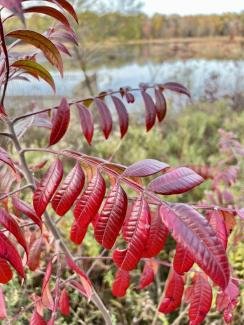
Habitat: Dry, rocky woodlands and barrens, shale barrens, old fields, fencerows, roadsides, and early-successional forests. Common at lower elevations nearly throughout.
Wildlife Value: This plant provides nectar for pollinators. It is a larval host plant for Red-Banded Hairstreak. It is also a host plant for the Luna moth. Butterflies and bees nectar at the flowers. Its fruits are eaten by songbirds, white-tailed deer, opossums, wild turkey, and quail. Its bark is eaten by rabbits. Plant NOVA Natives lists this species as particularly popular with the non-native honeybees
Notes: Glossy foliage, beautiful vivid red in the fall. Large mid-summer pale yellow blooms. Spreads slowly by suckers to form a colony (this can be controlled by weeding or mowing in the spring). Usually (but not always) two plants are needed for the female to produce the gorgeous berries
Earth Sangha Inventory
Founded in 1997, the Earth Sangha is a nonprofit public charity based in the Washington, DC, region. The Wild Plant Nursery is the most comprehensive source of local-ecotype, native plants in the Washington DC region, and the region’s only facility dedicated exclusively to this type of propagation. “Local-ecotype” plants are propagated from local, wild, naturally-occurring populations and are well-adapted to local conditions and for wildlife species that depend on the local forms, such as pollinators. Inventory is updated on a weekly basis so number may not be accurate.
| Pots Available | Plugs Available | Location | Notes | ||
|---|---|---|---|---|---|
| 71 | 0 | Row K, Row O | View My Wishlist |
Carniola Farms Nursery
Nursery operates Arlington Native Plants & Edibles located at 925 N. Madison St. Arlington Virginia 22205. Plants can be purchased at any time by making an email appointment at carniolafarms@gmail.com. Also, during the during the planting season, they are open some Saturdays from 11AM to 3PM. Check their website for datesThis plant list is from the beginning of the 2025 season and may be out-of-date
| In Stock? | Notes | ||
|---|---|---|---|
| Yes | View My Wishlist |
Bona Terra Nursery
Small family-run native plant nursery with a focus on the local genetics necessary to restore diversity in the Chesapeake eco-region. Offers free remote design service for small gardens up to 400 square feet. Orders are placed via email and items can be picked up at their NW DC office or delivered for a fee. This plant list is from the beginning of the 2025 season and may be out-of-date
| Pots Available | Pot Size | Notes | Add to Wishlist | |
|---|---|---|---|---|
| 0 | 3 Gallon |
Local Ecotype coming soon! |
View My Wishlist |

